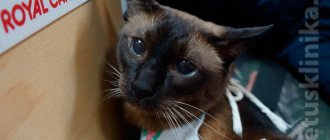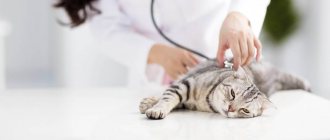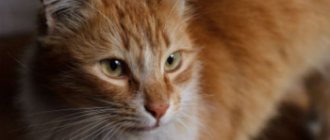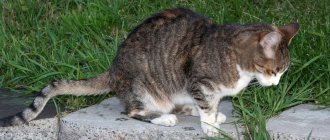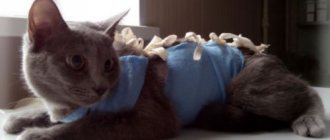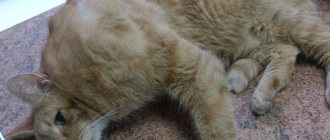Cats, like people, are susceptible to colds. But this disease in mustachioed pets is much more difficult. Colds in cats cause a lot of trouble for their owners. In our article we will talk about the symptoms of a cold, its consequences, prevention, methods of treatment, including at home.
Causes of the disease
The disease can occur for a number of reasons, including:
- Improper maintenance of a mustachioed pet. A cat can become hypothermic while outside or on a balcony; catch a cold due to drafts moving around the room; “earn” a runny nose if the hair remains wet after washing.
- Viral infection. Pets can become ill by contracting the disease from sick street animals.
Incorrectly selected food, lack of proper care, and the presence of chronic illnesses weaken the body’s immune system; weakened immunity contributes to the development of colds.
If the owner is confident that the animal is being kept properly and there are symptoms of the disease, then it is necessary to treat the animal for a viral infection.
Veterinarians call the disease “rinotracheitis”, it refers to complex diseases, the causative agent is a virus located in the external environment, found in the urine, feces, and secretions of a sick individual. Can be transmitted through direct contact by airborne droplets.
A cat that doesn't go outside can still become infected. The pathogen can enter the apartment by ending up on the owner’s street shoes or clothes.
Causes of colds in cats
Cat colds are a series of infectious diseases of the upper respiratory tract. It responds well to treatment, but lack of timely treatment can lead to serious complications. The immune system of cats is quite well developed and often copes with viruses on its own, so colds in cats are not so common. Among the main causes of infection is decreased immunity and contact with virus carriers.
An unbalanced diet, poor maintenance, low ambient temperature, drafts and stress can trigger the development of a cold in a cat.
Symptoms
The clinical picture of a viral infection and a cold is easy to confuse; the symptoms are almost the same.
Sick beast:
- feels weak, constantly lies down, stops playing;
- loses interest in his surroundings;
- practically stops eating;
- has difficulty breathing;
- begins to cough, sneeze;
- discharge appears from the sinuses;
- lacrimation is observed;
- the nasal mucosa becomes hot and dry;
- body temperature rises.
Be sure to read:
Immunodeficiency in cats: description, stages, symptoms, how to treat, what is FIV, is it dangerous?
The clinical picture of a viral infection can be complemented by the following signs:
- the lymph nodes located under the jaw increase in size;
- the nasal sinuses become covered with a white coating;
- the cat has difficulty eating and drinking water;
- Ulcers form on the mucous membranes of the lips, tongue, and eyes.
Can a cat catch a cold? What are the first symptoms?
Colds are usually caused by exposure to viruses. This type of disease is characterized by certain symptoms that are easy to notice in your pet . If your cat has a cold , you need to pay attention to its behavior
.
Knowing the signs of a cold in cats , it becomes possible to quickly respond to their manifestations and seek help from a veterinary center. This will avoid complications and deterioration of the pet’s condition.
- So, here are the main symptoms of colds in cats:
- apathy and weakness - a cat is not the most active representative of the fauna and loves to lie in its favorite place. This lazy pet behavior is normal. But when the animal does not react in any way to your attempt to play with it and practically does not move from its place, it is worth thinking about;
- Nasal discharge - colds in cats may be accompanied by characteristic nasal discharge. Along with them, bad enzymes and microorganisms leave the animal’s body. The discharge itself has a transparent color and a viscous consistency. But if they take on the hue of purulent discharge mixed with blood, you urgently need to seek help from a veterinarian, this is a dangerous sign;
- sneezing and coughing - by coughing and sneezing, the cat clears its airways. If you cough frequently, you should make sure that there are no foreign bodies in the respiratory tract that make breathing difficult;
- discharge from the eyes;
- loss of appetite - during the course of the disease, intoxication occurs. It is characterized by decreased appetite. A cat may not eat well, but it should drink as much as it needs. Therefore, the bowl of water should always be full and the contents clean. If loss of appetite lasts more than 36 hours, you should take the animal to the veterinarian and describe the change in its behavior;
- inflammation of the mucous membranes - this symptom is not typical for all cats. Basically, the redness of the mucous membranes in an animal depends on the characteristics of the breed. In some cases, it may indicate a change in blood pressure;
- increase in body temperature - if the cat is lethargic, and the thermometer readings show significant deviations from the norm, you should start to worry. High body temperature may indicate an inflammatory process in the body.
If you notice one of the symptoms of a cold, do not delay and immediately contact a veterinary center for help. Our specialists will arrive within 40 minutes and will provide all the necessary measures.
The cat has a cold and is sneezing: what to do?
If your pet is sneezing, coughing, the nose is dry and hot, the eyes are watery, there is no appetite, breathing is difficult, you should give the cat first aid.
Algorithm of actions:
- Carry out a visual inspection, analyze whether the disease is the result of a viral infection.
- Place the sick person in a comfortable, warm place, making sure there are no drafts.
- Put a heating pad on if the animal is cold.
- Give plenty of warm water and milk. Cold drinks are prohibited.
- Massage your body to increase blood circulation.
- Offer nutritious food.
If after two or three days the pet’s condition remains unchanged, you must visit a veterinary clinic, where the doctor will make an accurate diagnosis.
Prevention
A cat may develop colds if it has a heat exchange disorder. In its normal state, a layer of air forms in its undercoat, something like a “thermos”, which reliably protects it from colds and prevents heat loss. When it gets wet, the “thermos” does not work, and the cat begins to freeze, at which time she becomes most vulnerable to drafts. If a cat comes home cold and wet after going outside, then the first thing to do is to provide him with warmth and quickly dry the animal.
The kitten must be protected during bathing, provided with the water temperature necessary for its body, and a warm towel. It must be remembered that the water temperature that is pleasant for bathing people will be low for cats. The most acceptable water temperature for bathing mustaches is 39-40 degrees. After bathing, the cat must be wrapped in a warm towel prepared in advance and pressed against your arms. This way the pet will calm down and warm up better.
If your cat gets a cold during a walk and does not recover with home remedies, then you need to contact a veterinarian as soon as possible. It will help cure a sick animal.
How to treat at home
A calm course of the disease requires treatment at home.
A number of activities should be included in therapy:
- Provide coziness and comfort.
- Ease your general condition.
- Relieve symptoms.
- Stop further development of the disease.
Before starting drug therapy, you should monitor the body's reaction; perhaps the animal will recover without medication.
It is useful to include inhalations based on eucalyptus oil and eucalyptus leaves in therapy.
The procedure is carried out as follows:
- Prepare a decoction from the leaves of the plant, place a hot pan indoors (bathroom).
- Wrap the animal in a terry towel so that the cat cannot resist.
- Move your muzzle to the pan with healing steam.
- Make sure that the animal does not get burned.
- Do inhalation for 10-15 minutes, 2 times a day.
The eyes and nasal passages are washed with warm water to relieve the general condition.
Diagnostic techniques
Of course, the clinical picture and symptoms in most cases are quite sufficient to make a diagnosis, but in this case the veterinarian is not interested in the fact of a cold itself, but in the type of pathogen. To identify the exact root cause, specialists use a range of diagnostic tests.
In practice, the following types of analyzes are used:
- A complete blood test that helps assess the physiological state of the animal and the level of leukocytes, indicating the intensity of inflammatory reactions in its body.
- A chemical blood test is also important. It is used to evaluate the health of the kidneys, liver, and pancreatic function (looking not only at sugar levels, but also at the amount of insulin).
- The blood is also checked for the amount of electrolytes. This is especially important for young animals if dehydration is suspected. In addition, the analysis is important for assessing the condition of the kidneys.
- If viral infections are suspected, urine tests are required, since these pathologies often affect not only the upper respiratory tract, but also the kidneys.
- There are also specific serological tests that detect feline leukemia virus (FeLV) and feline immunodeficiency virus (FIV).
- For chronic colds, radiography and ultrasound of the sinuses of the skull and nasal cavity are desirable, as well as cytological and microscopic examination of scrapings from the surface of the nasal cavity.
Treating cat colds with medications
Treatment of the animal is carried out at home, after consulting with a veterinarian. It is difficult to give medications in tablet form to cats because of the bitter taste.
It is forbidden to give antipyretic drugs (aspirin, paracetamol) to cats due to the toxic effects on the animal’s body.
To reduce the temperature, use a cool, damp compress, which is placed on the animal’s head.
Be sure to read:
Borreliosis in cats: symptoms, diagnosis, treatment
Excessive liquid discharge from the sinuses is treated with nasal drops that are prescribed to the person. A runny nose can be relieved by Nazivin and Xylometazoline. 1 drop in each nasal passage 2 times a day.
Only a veterinarian can prescribe antibacterial agents (antibiotics); the doctor will recommend the drug and determine the dose.
A sick cat is prescribed drugs of the tetracycline group. The medication is taken 2 times a day.
Drugs for treatment:
- "Ampicillin"
- "Streptomycin",
- "Tetracycline"
- "Amoxicillin"
- "clindamycin"
When treating colds, Interferon and Immunoglobulin are used in injections.
To strengthen the immune system, injections of B vitamins are recommended.
Drug therapy
If your kitten's cold does not go away with home treatment, then you should visit a doctor. He will check the animal and prescribe appropriate treatment. The treatment plan includes taking medications, which must be done exclusively according to the instructions of a specialist.
The veterinarian usually prescribes the following remedies if the cat has a cold:
- Antipyretic medications if you have a fever.
- Expectorants for wheezing.
- Drugs that destroy pathogenic microorganisms.
- Medicines that help normalize immune function.
- Vitamins.
Antibiotics are prescribed only if the cold is severe or is accompanied by another infectious disease. If a kitten refuses to eat water for a long time, the veterinarian may recommend giving him IV drips.
After all, a lack of water in the body is dangerous and can lead to death.
Possible consequences of a cold
It can be difficult for cat owners to understand that the disease is not typical for a small predator, and the complications, if left untreated, are extremely dangerous. A cat's illness rarely poses a danger to the human body, but can be transmitted to other four-legged and feathered inhabitants of the apartment.
If you ignore the primary symptoms and do not start treatment in time, the disease progresses to a serious stage.
Typical complications:
- bronchitis,
- pneumonia,
- joint damage,
- genitourinary infections.
Also, the immune system weakened by the disease is a poor “protector” for the animal. Viruses brought by the owner on street clothes and shoes can easily infect a sick body.
How can you get sick
As mentioned above, the key aspects of a cold can be considered hypothermia, weakened immunity and viral infection. Hence the risk factors that dramatically increase the likelihood of a kitten catching a cold.
- Hypothermia. That is, prolonged exposure to the cold - for example, outside in winter, during rain, strong cold wind, etc. Keeping a cat in a damp, cold room can also lead to this.
Read more about the dangers of cold: Dangers of Cold for Cats
- Separately, it is worth mentioning the possibility of hypothermia during or after swimming. Even a temperature difference of a few degrees can cause your kitten to catch a cold. Therefore, if you decide to bathe your pet, be especially attentive to the room temperature (the optimal range for cats is considered to be from +18 to +24), avoid drafts, immediately after bathing, wrap tightly in a towel and keep it there until the fur dries.
Read more about bathing cats: Should you wash your cat?
- Drafts themselves can lead to a cold. Especially in autumn and spring - when the temperature outside is already or still low (but sufficient for people to want to ventilate the room), and there is no heating.
- Previous infections increase the risk of developing a new disease. The disease causes the immune system to weaken and the body to become more vulnerable for some time. Without proper care, the risk of re-infection increases.
- An unbalanced diet, a deficiency of vitamins and nutrients in the body lead to a decrease in immunity and a weakening of protective functions. As a result, it becomes easier for various pathogens to gain a foothold and begin to multiply.
Drug course of treatment
As for what medications to treat a cat with, they must be prescribed by the veterinarian himself, after examining and examining the pet. So, in each specific case, the course of treatment includes the following measures:
- course of symptomatic treatment. In this case, doctors most often prescribe drops or special solutions to the animal to cleanse the nasal passages of mucous secretions and dried crusts that have formed. Such preparations can be a 0.5% solution of tannin or zinc sulfate 2% strength, boric acid 3%.
- doctors prescribe a course of antibiotics - they allow you to stop and suppress the very process of growth and development of pathogenic bacteria and fungi that affect the respiratory system.
- A course of taking immunomodulators is also indicated - this strengthens the animal’s immunity and helps speed up the healing process itself.
Also, during the general course of therapy, the use of runny nose and lacrimation with the help of special drops is indicated. In any case, all actions and course of treatment, medications should be coordinated with a veterinarian.
